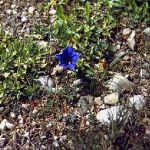| Common Name: |
Japanese Gentian |
| Other Names: |
Ryntem Root |
| Botanical Name: |
Gentiana scabra |
| Genus: |
Gentiana |
| Family: |
Gentianaceae |
| Cultivation: |
Moist, light, well-drained, rich, neutral to acid soil in sun or partial shade. Gentiana lutea prefers alkaline soil. Plants may succumb to root rot in wet conditions. |
| Propagation: |
By seed sown when ripe; by division or offshoots in spring. |
| Harvest: |
Roots and rhizomes are lifted in autumn and dried for use in decoctions, tablets, and tinctures. |
| Native Location: |
N Asia, Japan |
| Height: |
30cm (12in) |
| Width: |
20cm (8in) |
| Hardiness: |
Z5-9 |
| Parts Used: |
Roots (long dan cao) |
| Properties: |
A bitter, cooling, anti-inflammatory herb that stimulates the appetite and digestion, increases blood sugar leves, and potentiates the sedative and analgesic properties of other herbs. |
| Medicinal Uses: |
Internally for liver disorders, eye complaints related to liver disharmony (such as conjunctivitis), acute urinary infections, hypertension with dizziness or tinnitus, and tantrums in children. Included in many Chinese patent remedies for "liver heat". |
| Bibliography: |
Encyclopedia of Herbs by Deni Brown. Copyright © 1995, 2001 Dorling Kindersley Limited. pg 222-223
|

